Phase Composition and Microstructure of Cast Al-6%Mg-2%Ca-2%Zn Alloy with Fe and Si Additions
Abstract
:1. Introduction
2. Materials and Methods
2.1. Alloys and Samples Preparation
2.2. Microstructure and Phase Transformations Analysis
2.3. Physical and Mechanical Testing
3. Results
3.1. As-Cast Microstructure and Phase Identification
3.2. Microstructure and Phase Composition of Solid Solution-Treated Alloys
3.3. Investigation of the Microstructure of the Slowly Solidified Alloys
4. Discussion
4.1. Liquidus Surfaces of the Al-Mg-Ca-Zn-(Fe)-(Si) System
4.2. Polythermal Phase Diagram Cross-Section Calculation for Investigated Alloys of Multicomponent Systems Al-Mg-Ca-Zn-Fe-Si
4.3. Non-Equilibrium Crystallisation of the Experimental Alloys According to the Scheil–Gulliver Model
4.4. Calculated Phase Composition
4.5. Analysis of Samples after Quenching and Artificial Ageing
5. Conclusions
- Using Thermo-Calc software, the phase diagram of the Al-Mg-Ca-Zn-Fe-Si system has been constructed. The qualitative and quantitative phase composition of the investigated alloys and their critical temperatures have been determined. The alloys with up to 0.7%Fe should not contain the primary Al3Fe phase. The total calculated mass fraction of all phases in all investigated alloys was more than 25%. Except for the peritectic reactions, the experimental results agreed with the calculations;
- The alloy Al-6%Mg-2%Ca-2%Zn-0.5%Fe was found to have a microstructure containing an ultrafine multiphase eutectic. The alloy also showed superior mechanical properties compared to the Si-containing alloys and some standard alloys. The Fe-containing intermetallics were finely incorporated in the eutectic, and their sizes did not exceed 3 µm. A higher Fe concentration leads to the formation of primary Al3Fe crystals whose sizes are even smaller than those of the Al2CaSi2 phase found in the Si-containing alloys;
- In the microstructure of slowly solidified Al-6%Mg-2%Ca-2%Zn-0.5%Fe alloy, the ternary Al10CaFe2 intermetallic was not revealed. This indicates that the possible peritectic reaction L + Al3Fe → α-Al + Al10CaFe2 does not take place in the considered range of Mg, Ca, and Fe concentrations;
- The Si-containing alloys show coarser eutectic, which was characterized by needle-shaped elongated colonies. EDS analysis showed the presence of Ca, Zn, and Si, which allowed us to identify (Al,Zn)4Ca and Al2CaSi2 intermetallics. Since no other phases with Si were found, we can conclude that the peritectic reaction L + Al2CaSi2 → L + Mg2Si was suppressed;
- The complex composition of (Al,Zn)4Ca + Al2CaSi2 intermetallics mixture suggests that the aluminide Al2CaSi2, due to earlier crystallization, could be a substrate for the other intermetallic phases with Ca, resulting in their coarser morphology. Assumingly, the higher brittleness of such a complex compound leads to lower mechanical properties (YS 131 MPa versus 146 MPa in 622S and 622F, respectively) and ductility.
Author Contributions
Funding
Data Availability Statement
Acknowledgments
Conflicts of Interest
References
- Belov, N.A.; Zolotorevskij, V.S. The effect of nickel on the structure, mechanical and casting properties of aluminium alloy of 7075 type. Mater. Sci. Forum 2002, 396–402, 935–940. [Google Scholar] [CrossRef]
- Mann, V.K.; Alabin, A.N.; Krokhin, A.Y.; Frolov, A.V.; Belov, N.A. New generation of high strength aluminum casting alloys. Light Met. Age 2015, 73, 44–47. [Google Scholar]
- Lin, J.C.; Glazoff, M.V.; Zolotorevsky, V.S.; Murtha, S.J.; Belov, N.A. An Al–Ni–Mn Casting Alloy for Automotive and Aerospace Structural Components. U.S. Patent 6,783,730, 31 August 2004. [Google Scholar]
- Glazoff, M.; Khvan, A.; Zolotorevsky, V.; Belov, N.; Dinsdale, A. Casting Aluminum Alloys: Their Physical and Mechanical Metallurgy, 2nd ed.; Elsevier: London, UK, 2018; p. 608. [Google Scholar]
- Mo, L.; Zhou, X.; Liu, X.; Zhan, M.; Zhao, Y.-J.; Du, J. Microstructure and thermal-physical properties of hypereutectic Al-Ni alloys. J. Mater. Res. Technol. 2023, 24, 6227–6237. [Google Scholar] [CrossRef]
- Jiang, M.; Mo, L.; Zhou, X.; Liu, X.; Zhan, M.; Du, J. Microstructure Evolution and Thermophysical Properties of Hypereutectic Al-Fe-Ni Alloys. Int. Metalcast. 2023. [Google Scholar] [CrossRef]
- Babilas, R.; Młynarek-Żak, K.; Łoński, W.; Łukowiec, D.; Lis, M.; Kądziołka-Gaweł, M.; Warski, T.; Radoń, A. Influence of Fe, Cr, and Cu addition on the microstructure, hardness, and anticorrosion properties of Al–Ni–Y alloys. Arch. Civ. Mech. Eng. 2022, 22, 82. [Google Scholar] [CrossRef]
- Su, Z.; Xiao, Z.; Zeng, Z.; Jiang, B.; Ma, C.; Yang, P.; Wang, Y.; Xu, S. Microstructure and mechanical properties of squeeze-cast Al-5.0Cu-1Mn-based alloys with different Ni content. Mater. Des. 2023, 229, 111901. [Google Scholar] [CrossRef]
- Rogachev, S.O.; Naumova, E.A.; Lukina, E.A.; Zavodov, A.V.; Khatkevich, V.M. High Strength Al–La, Al–Ce, and Al–Ni Eutectic Aluminum Alloys Obtained by High-Pressure Torsion. Materials 2021, 14, 6404. [Google Scholar] [CrossRef]
- Akopyan, T.K.; Belov, N.A.; Naumova, E.A.; Letyagin, N.V. New in-situ Al matrix composites based on Al-Ni-La eutectic. Mater. Lett. 2019, 245, 110–113. [Google Scholar] [CrossRef]
- Belov, N.A.; Naumova, E.A.; Eskin, D.G. Casting alloys of the Al–Ce–Ni system: Microstructural approach to alloy design. Mater. Sci. Eng. A 1999, 271, 134–142. [Google Scholar] [CrossRef]
- Shen, S.; Wu, C.; Li, Y.; Huang, Y.; Huang, W.; Zhang, P.; Zhong, S.; Lu, Y.; Luo, G.; Gan, Z.; et al. Refining mechanism and elevated-temperature mechanical properties of Al-Ce alloys solidified under super gravity field. Mater. Sci. Eng. A 2023, 879, 145191. [Google Scholar] [CrossRef]
- Yi, M.; Zhang, P.; Yang, C.; Cheng, P.; Guo, S.; Liu, G.; Sun, J. Improving creep resistance of Al-12 wt.% Ce alloy by microalloying with Sc. Scr. Mater. 2021, 198, 113838. [Google Scholar] [CrossRef]
- He, Y.; Liu, J.; Qiu, S.; Deng, Z.; Zhang, J.; Shena, Y. Microstructure evolution and mechanical properties of Al-La alloys with varying La contents. Mater. Sci. Eng. A 2017, 701, 134–142. [Google Scholar] [CrossRef]
- Kozakevich, J.R.; Stroh, J.; Sediako, D.; Weiss, D. Solidification Kinetics of an Al-Ce Alloy with Additions of Ni and Mn. Metals 2023, 13, 955. [Google Scholar] [CrossRef]
- Deev, V.; Prusov, E.; Shurkin, P.; Ri, E.; Smetanyuk, S.; Chen, X.; Konovalov, S. Effect of La Addition on Solidification Behavior and Phase Composition of Cast Al-Mg-Si Alloy. Metals 2020, 10, 1673. [Google Scholar] [CrossRef]
- Rogachev, S.O.; Naumova, E.A. Thermal Stability of Al-Ca and Al-Ce Alloys Obtained by High-Pressure Torsion. J. Mater. Eng. Perform. 2021, 30, 9192–9199. [Google Scholar] [CrossRef]
- Akopyan, T.K.; Letyagin, N.V.; Avxentieva, N.N. High-tech alloys based on Al–Ca–La(–Mn) eutectic system for casting, metal forming and selective laser melting. Non-Ferr. Met. 2020, 48, 52–59. [Google Scholar] [CrossRef]
- Naumova, E.; Doroshenko, V.; Barykin, M.; Sviridova, T.; Lyasnikova, A.; Shurkin, P. Hypereutectic Al-Ca-Mn-(Ni) Alloys as Natural Eutectic Composites. Metals 2021, 11, 890. [Google Scholar] [CrossRef]
- Wu, Z.; Zhang, H.; Tang, S.; Zou, J.; Yang, D.; Wang, Y.; Qin, K.; Ban, C.; Cui, J.; Nagaumi, H. Effect of calcium on the electrochemical behaviors and discharge performance of Al–Sn alloy as anodes for Al–air batteries. Electrochim. Acta 2021, 370, 137833. [Google Scholar] [CrossRef]
- Rogachev, S.O.; Zavodov, A.V.; Naumova, E.A.; Chernenok, T.V.; Lukina, E.A.; Zadorozhnyy, M.Y. Improvement of strength–ductility balance of Al–Ca–Mn–Fe alloy by severe plastic deformation. Mater. Lett. 2023, 349, 134797. [Google Scholar] [CrossRef]
- Zhang, S.; Du, H.; Yao, Z.; Liu, Z.; Zhu, Y.; Shuai, L.; Huang, T.; Huang, X.; Tao, X.; Mondal, D.P.; et al. Superior high temperature creep resistance of a cast Al–Mg–Ca-Sc alloy with multi-scale hierarchical microstructures. Mater. Sci. Eng. A 2022, 850, 143533. [Google Scholar] [CrossRef]
- Doroshenko, V.V.; Barykin, M.A.; Vasina, M.A.; Aksenov, A.A. Combined effect of calcium and zinc on the hot cracking of Al–Mg alloys. Tsvetnye Met. 2022, 12, 48–57. [Google Scholar] [CrossRef]
- Letyagin, N.V.; Musin, A.F.; Sichev, L.S. New aluminum-calcium casting alloys based on secondary raw materials. Mater. Today Proc. 2021, 38, 1551–1555. [Google Scholar] [CrossRef]
- Glavatskikh, M.V.; Barkov, R.Y.; Gorlov, L.E.; Khomutov, M.G.; Pozdniakov, A.V. Novel Cast and Wrought Al-3Zn-3Mg-3Cu-Zr-Y(Er) Alloys with Improved Heat Resistance. Metals 2023, 13, 909. [Google Scholar] [CrossRef]
- Shen, G.; Chen, X.; Yan, J.; Fan, L.; Yang, Z.; Zhang, J.; Guan, R. A Review of Progress in the Study of Al-Mg-Zn(-Cu) Wrought Alloys. Metals 2023, 13, 345. [Google Scholar] [CrossRef]
- Shen, G.; Xiang, Z.; Ma, X.; Huang, J.; Zhao, Y.; Li, J.; Wang, Z.; Shi, G.; Chen, Z. Investigation of Microstructures and Mechanical Properties of Ultra-High Strength Al-Zn-Mg-Cu Alloy Prepared by Rapid Solidification and Hot Extrusion. Metals 2023, 13, 293. [Google Scholar] [CrossRef]
- Hsiao, T.-J.; Chiu, P.-H.; Tai, C.-L.; Tsao, T.-C.; Tseng, C.-Y.; Lin, Y.-X.; Chen, H.-R.; Chung, T.-F.; Chen, C.-Y.; Wang, S.-H.; et al. Effect of Cu Additions on the Evolution of Eta-prime Precipitates in Aged AA 7075 Al–Zn–Mg–Cu Alloys. Metals 2022, 12, 2120. [Google Scholar] [CrossRef]
- Khomutov, M.G.; Pozdniakov, A.V.; Glavatskikh, M.V.; Barkov, R.Y.; Churyumov, A.Y.; Travyanov, A.Y. Effect of Thermal Deformation Treatment Regimes on Al–4.5Zn–4.5Mg–1Cu–0.12Zr–0.1Sc Alloy Structure and Properties. Metallurgist 2023, 66, 1225–1234. [Google Scholar] [CrossRef]
- Plotkowski, A.; Rios, O.; Sridharan, N.; Sims, Z.; Unocic, K.; Ott, R.T.; Dehoff, R.R.; Babu, S.S. Evaluation of an Al-Ce alloy for laser additive manufacturing. Acta Mater. 2017, 126, 507–519. [Google Scholar] [CrossRef]
- Zhang, X.; Li, L.; Wang, Z.; Peng, H.; Gao, J.; Peng, Z. A novel high-strength Al-La-Mg-Mn alloy for selective laser melting. J. Mater. Sci. Technol. 2023, 137, 205–214. [Google Scholar] [CrossRef]
- Shurkin, P.K.; Letyagin, N.V.; Yakushkova, A.I.; Samoshina, M.E.; Ozherelkov, D.Y.; Akopyan, T.K. Remarkable thermal stability of the Al-Ca-Ni-Mn alloy manufactured by laser-powder bed fusion. Mater. Lett. 2021, 285, 129074. [Google Scholar] [CrossRef]
- Plotkowski, A.; Sisco, K.; Bahl, S.; Shyam, A.; Yang, Y.; Allard, L.; Nandwana, P.; Rossy, A.M.; Dehoff, R.R. Microstructure and properties of a high temperature Al–Ce–Mn alloy produced by additive manufacturing. Acta Mater. 2020, 196, 595–608. [Google Scholar] [CrossRef]
- Rogachev, S.O.; Naumova, E.A.; Komissarov, A.A.; Vasina, M.A.; Pavlov, M.D.; Tokar’, A.A. Effect of Laser Surface Modification on the Structure and Mechanical Properties of Al–8% Ca, Al–10% La, Al–10% Ce, and Al–6% Ni Eutectic Aluminum Alloys. Russ. J. Non-Ferr. Met. 2022, 63, 671–680. [Google Scholar] [CrossRef]
- Ha, S.H.; Yoon, Y.O.; Kim, B.H.; Lim, H.K.; Lee, T.W.; Lim, S.H.; Kim, S.K. Oxide Scale Behavior and Surface Protection of Al–Mg Alloys Containing a Trace of Ca. Int. J. Metalcast. 2019, 13, 121–129. [Google Scholar] [CrossRef]
- Belov, N.A.; Naumova, E.A.; Akopyan, T.K. Eutectic Alloys Based on Aluminum: New Systems and Alloying. Ore and Metals: Moscow, Russia, 2016; p. 256. [Google Scholar]
- Mondolfo, L.F. Aluminum Alloys: Structure and Properties; Butterworths: Boston, London, 1976; p. 982. [Google Scholar]
- Shurkin, P.K.; Dolbachev, A.P.; Naumova, E.A.; Doroshenko, V.V. Effect of iron on the structure, hardening and physical properties of the alloys of the Al–Zn–Mg–Ca system. Tsvet. Met. 2018, 5, 69. [Google Scholar] [CrossRef]
- Naumova, E.A. Use of Calcium in Alloys: From Modifying to Alloying. Russ. J. Non-Ferr. Met. 2018, 59, 284–298. [Google Scholar] [CrossRef]
- Zolotorevskii, V.S.; Pozdnyakov, A.V.; Churyumov, A.Y. Search for promising compositions for developing new multiphase casting alloys based on Al-Cu-Mg matrix using thermodynamic calculations and mathematic simulation. Phys. Met. Metallogr. 2012, 113, 1052–1060. [Google Scholar] [CrossRef]
- Yun, J.; Kang, S.; Lee, D.; Bae, D. Development of heat-treatable Al-5Mg alloy sheets with the addition of Zn. Mater. Sci. Eng. A 2019, 744, 21–27. [Google Scholar] [CrossRef]
- Zhao, J.-W.; Luo, B.-H.; He, K.-J.; Bai, Z.-H.; Li, B.; Chen, W. Effects of minor Zn content on microstructure and corrosion properties of Al−Mg alloy. J. Cent. South Univ. 2016, 23, 3051–3059. [Google Scholar] [CrossRef]
- Wasiur-Rahman, S.; Medra, M. A thermodynamic description of the Al-Ca-Zn ternary system. Calphad 2009, 33, 584–598. [Google Scholar] [CrossRef]
- Thermo-Calc Software TTAL5 Al-Alloys. Available online: www.thermocalc.com (accessed on 10 March 2023).
- Moore, D.M.; Morris, L.R. A new superplastic aluminum sheet alloy. Mater. Sci. Eng. 1980, 43, 85–92. [Google Scholar] [CrossRef]
- Swaminathan, K.; Padmanabhan, K.A. Tensile flow and fracture behaviour of a superplastic Al—Ca—Zn alloy. J. Mater. Sci. 1990, 25, 4579–4586. [Google Scholar] [CrossRef]
- Perez-Prado, M.T.; Cristina, M.C.; Ruano, O.A.; Gonza, G. Microstructural evolution of annealed Al—5%Ca—5% Zn sheet alloy. J. Mater. Sci. 1997, 32, 1313–1318. [Google Scholar] [CrossRef]
- Kono, N.; Tsuchida, Y.; Muromachi, S.; Watanabe, H. Study of the AlCaZn ternary phase diagram. Light Met. 1985, 35, 574–580. [Google Scholar] [CrossRef]
- Belov, N.A.; Naumova, E.A.; Doroshenko, V.V.; Korotkova, N.O. Phase Composition, Structure, and Hardening of Alloys Containing 6% (Ca + Si) in the System Al–Ca–Si–Zr–Sc. Phys. Met. Metallogr. 2018, 119, 1184–1190. [Google Scholar] [CrossRef]
- Wang, T.; Zuo, X.; Zhou, Y.; Liu, Z. Stability mechanism of AlSi12 aluminum foam under the action of Al–Si–Ca second phase. J. Mater. Res. Technol. 2021, 11, 1991–2002. [Google Scholar] [CrossRef]
- Belov, N.; Akopyan, T.; Korotkova, N.; Murashkin, M.; Timofeev, V.; Fortuna, A. Structure and Properties of Ca and Zr Containing Heat Resistant Wire Aluminum Alloy Manufactured by Electromagnetic Casting. Metals 2021, 11, 236. [Google Scholar] [CrossRef]
- Belov, N.A.; Akopyan, T.K.; Korotkova, N.O.; Naumova, E.A.; Pesin, A.M.; Letyagin, N.V. Structure and Properties of Al-Ca(Fe, Si, Zr, Sc) Wire Alloy Manufactured from As-Cast Billet. JOM 2020, 72, 3760–3768. [Google Scholar] [CrossRef]
- Goswami, R.; Holtz, R.L. Transmission Electron Microscopic Investigations of Grain Boundary Beta Phase Precipitation in Al 5083 Aged at 373 K (100 °C). Met. Mater. Trans. A 2013, 44, 1279–1289. [Google Scholar] [CrossRef]
- Doroshenko, V.V.; Barykin, M.A.; Korotkova, N.O.; Vasina, M.A. The Effect of Calcium and Zinc on the Structure and Phase Composition of Casting Aluminum–Magnesium Alloys. Phys. Met. Metallogr. 2022, 123, 816–824. [Google Scholar] [CrossRef]
- DIN EN 1706; Aluminium and Aluminium Alloys—Castings. DEUTSCHE NORM: Berlin, Germany, 1998.

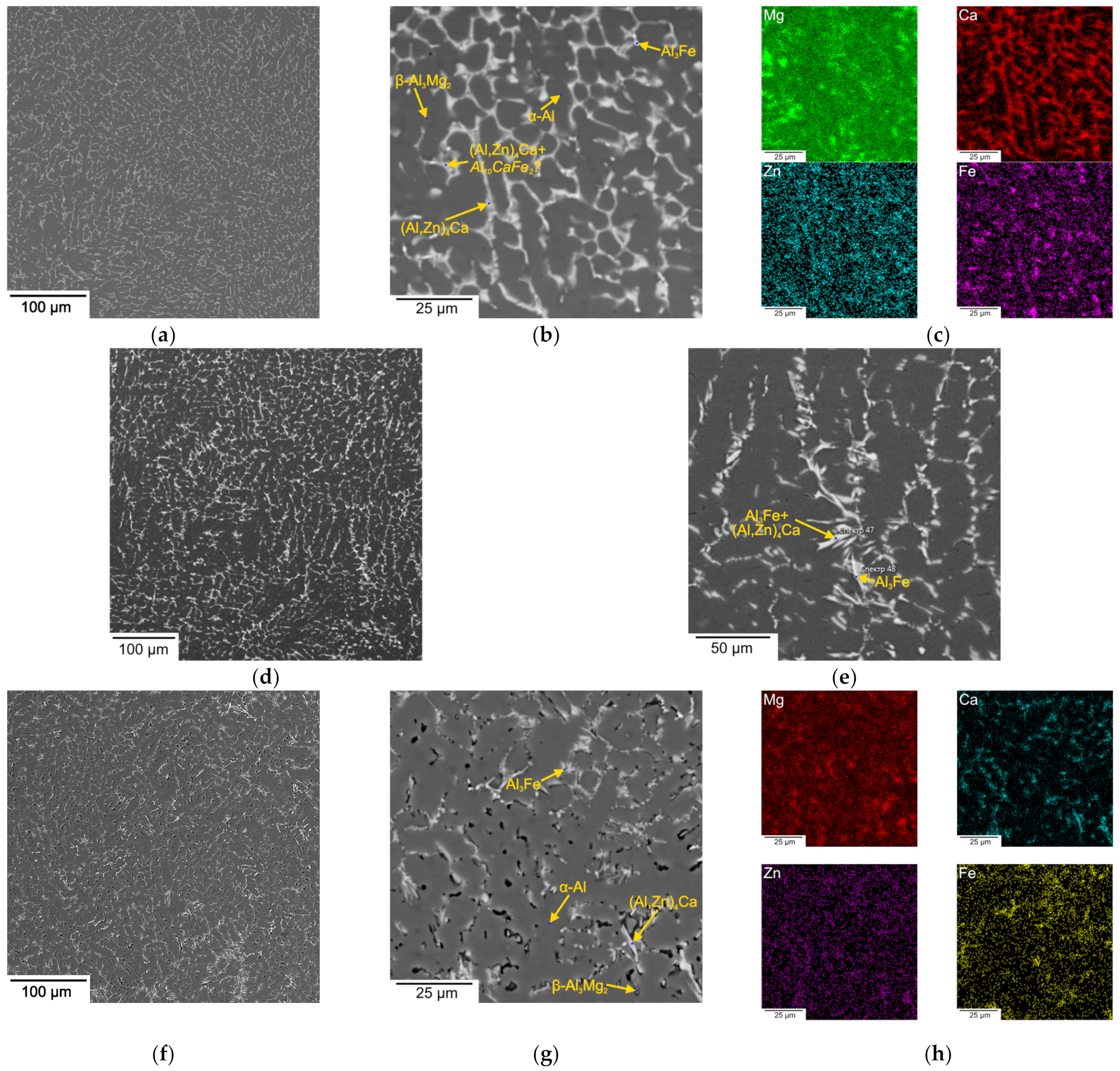

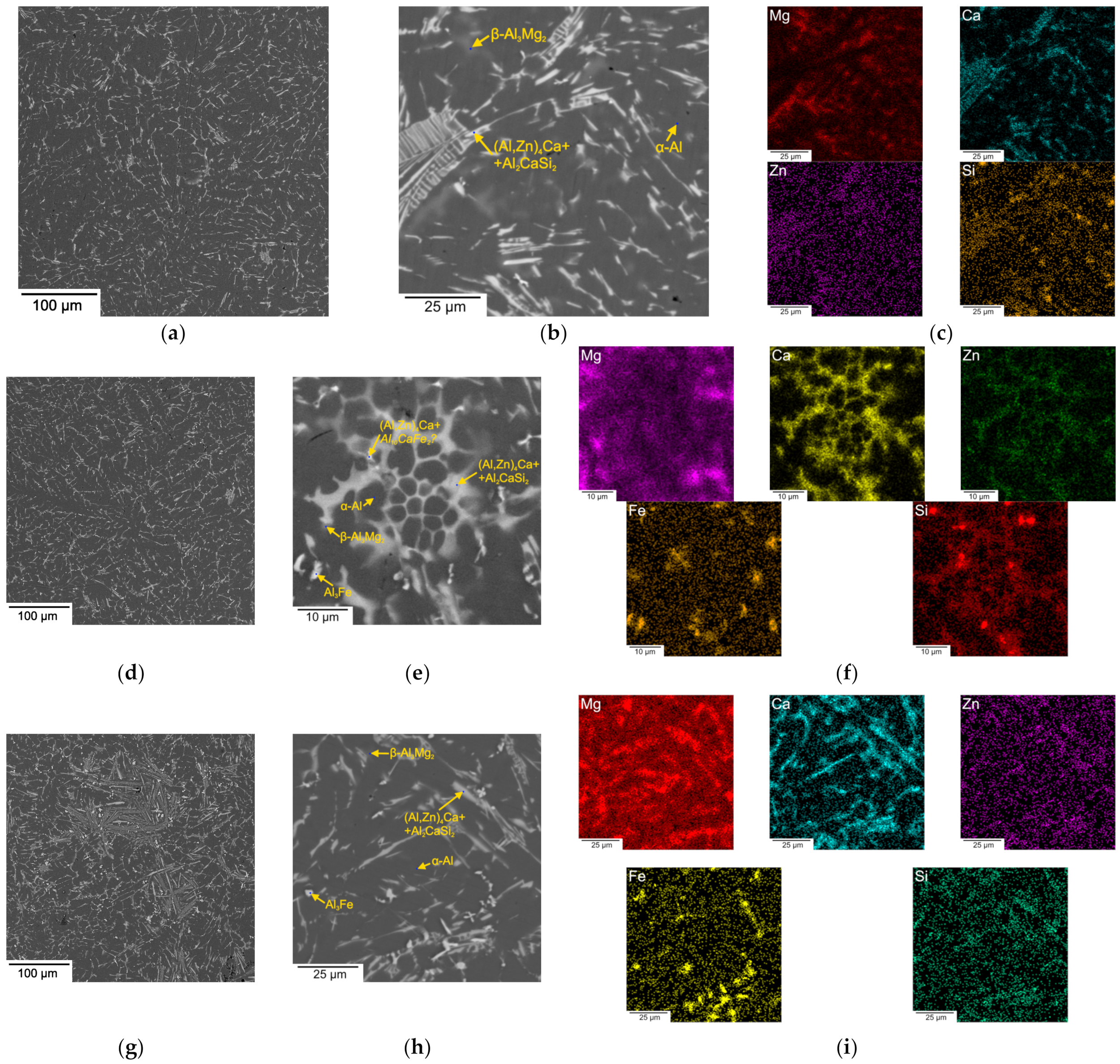

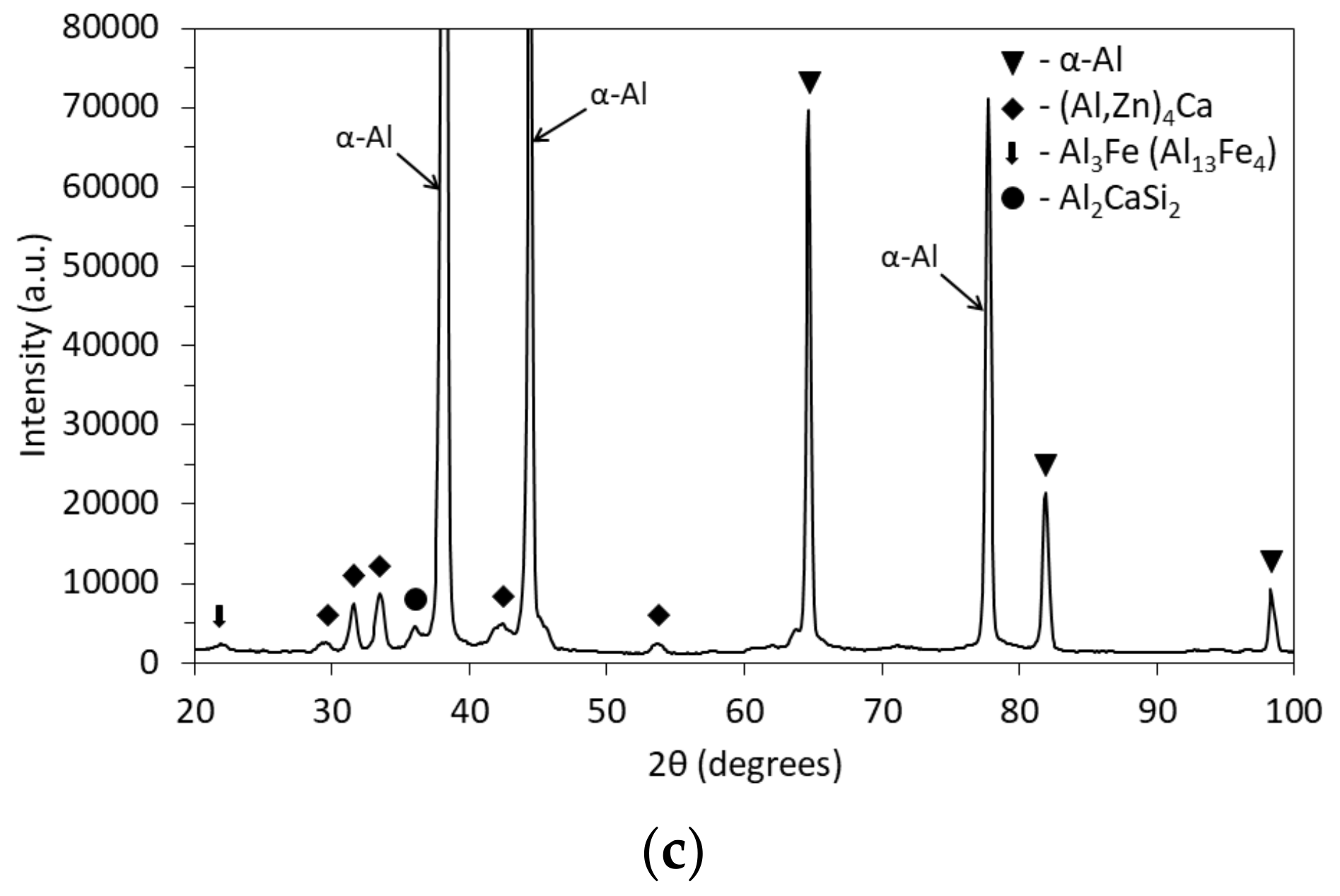
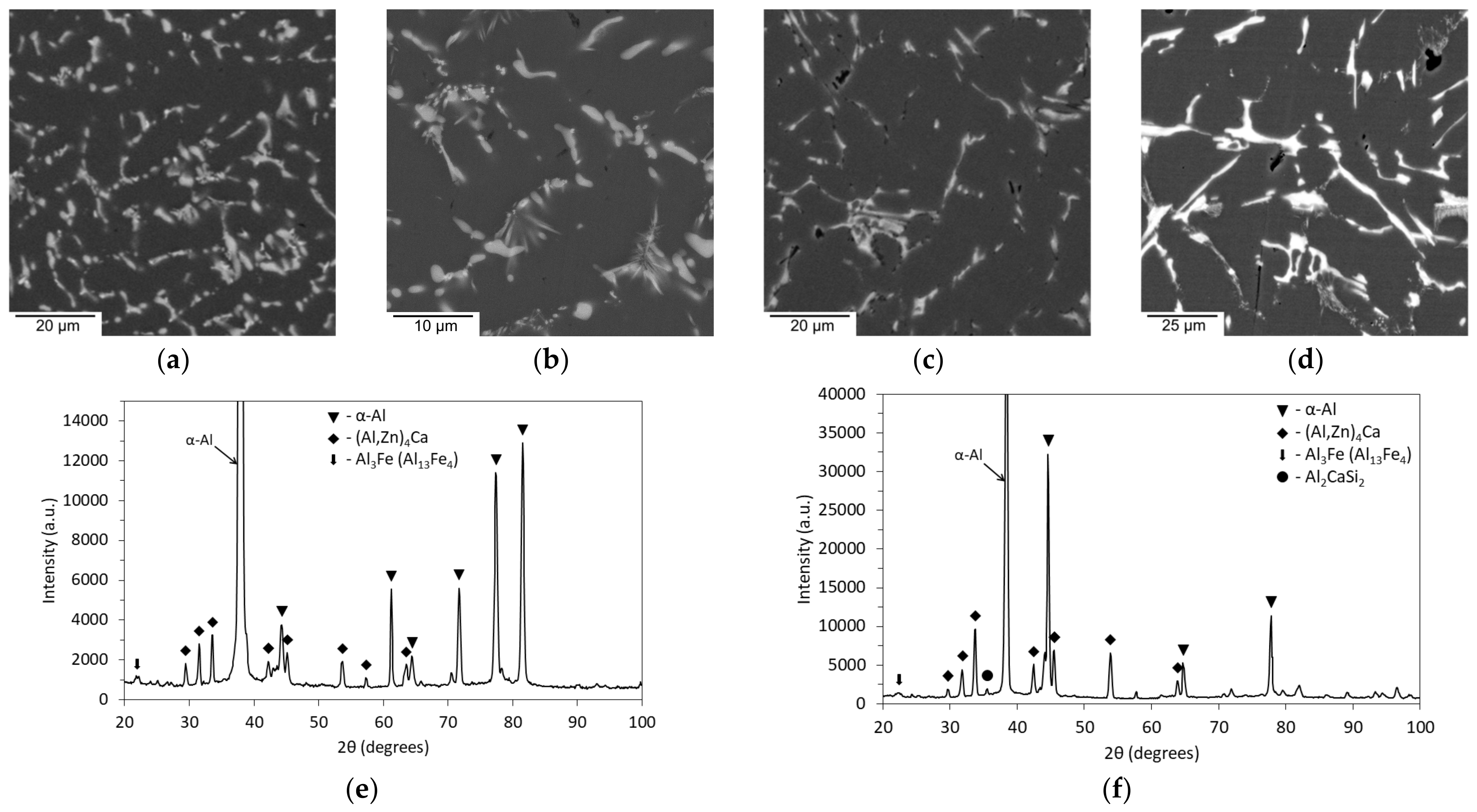




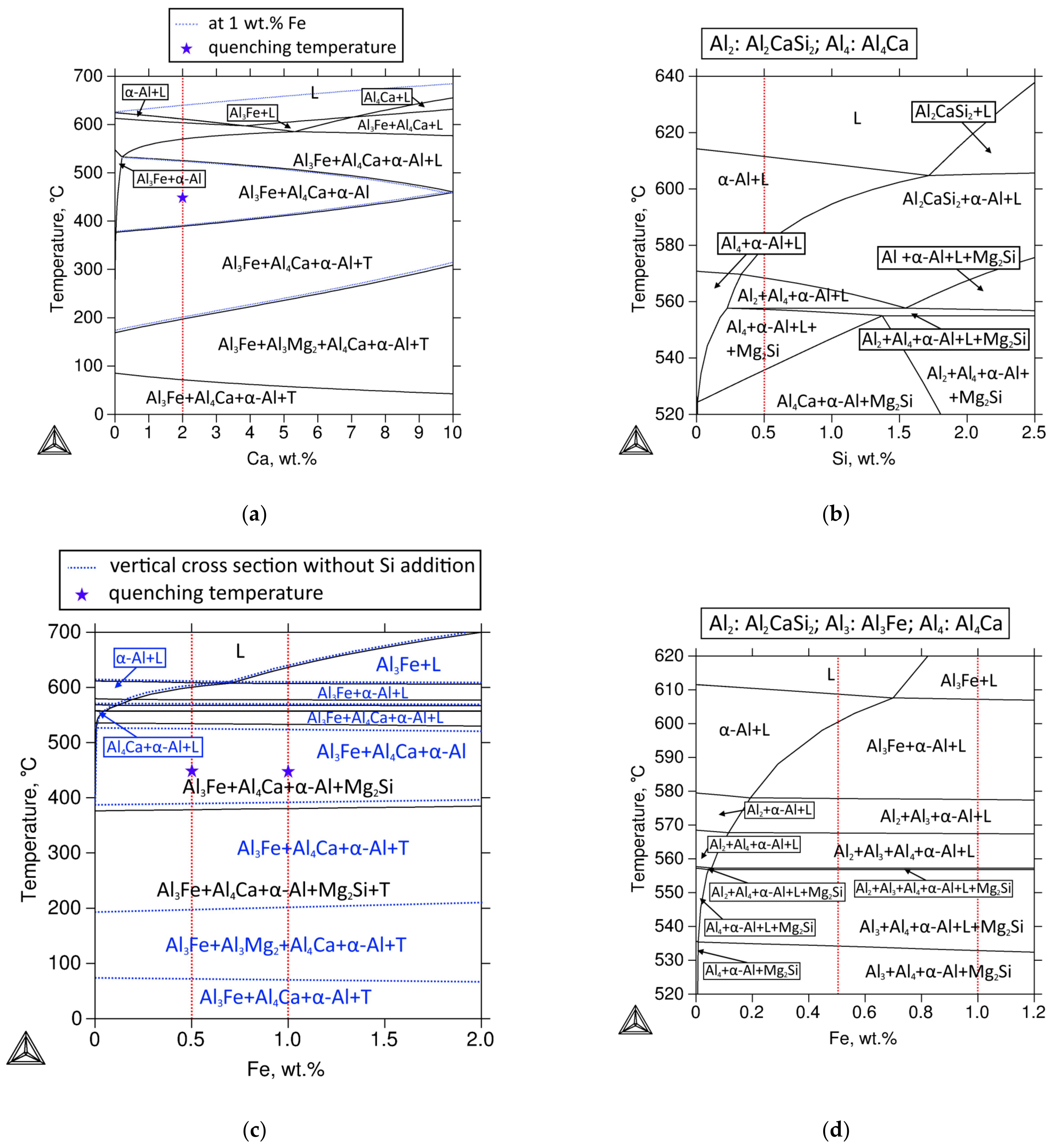
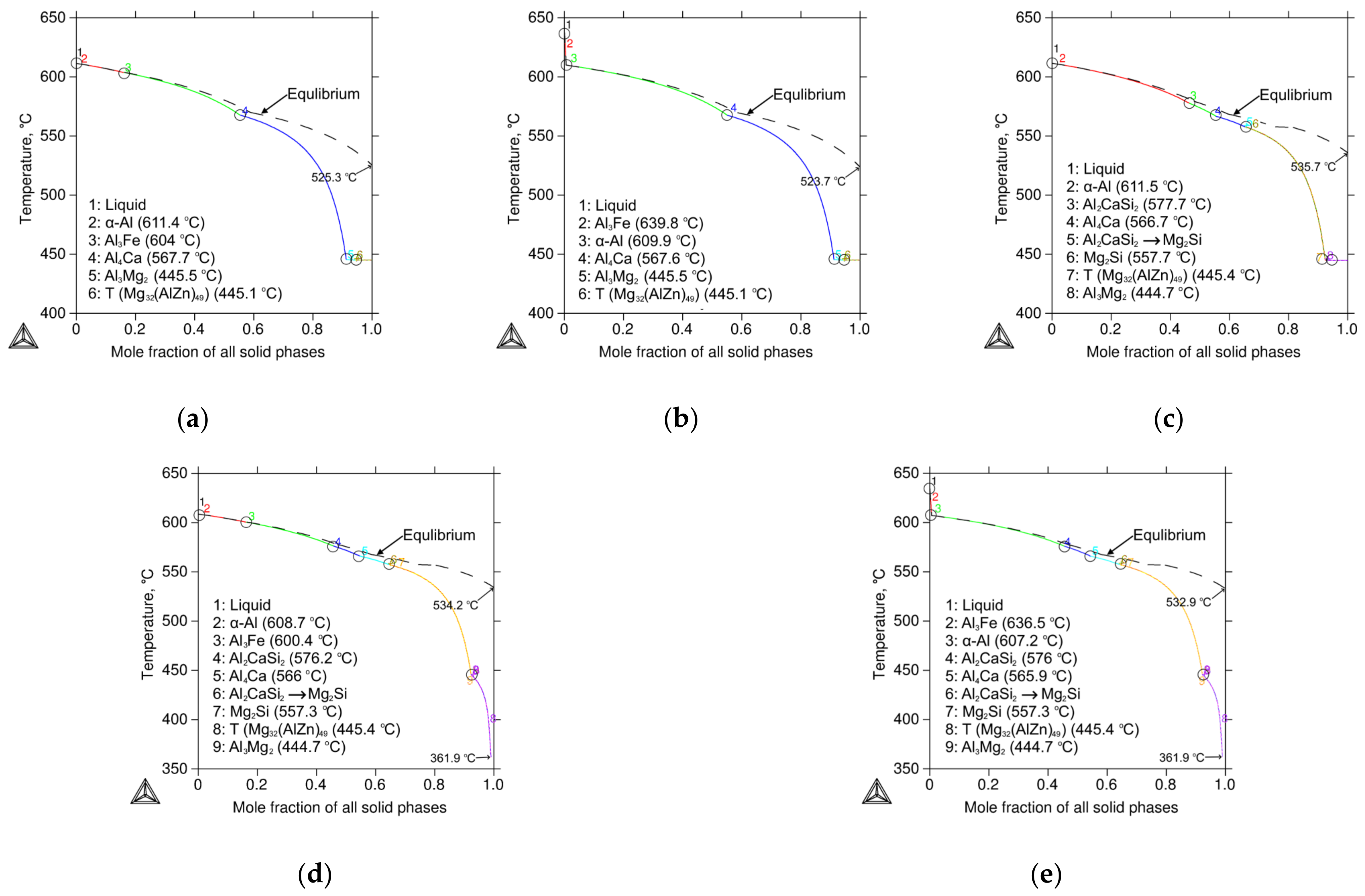

| Marking | Chemical Composition (Nominal/Actual), wt. % | |||||
|---|---|---|---|---|---|---|
| Al | Mg | Ca | Zn | Fe | Si | |
| 622F | Bal. | 6 (6.1) | 2 (2.2) | 2 (2.1) | 0.5 (0.6) | 0 |
| 622F0.7 | Bal. | 6 (5.8) | 2 (2.1) | 2 (2.1) | 0.7 (0.7) | 0 |
| 622F1 | Bal. | 6 (5.7) | 2 (1.8) | 2 (2.1) | 1 (0.9) | 0 |
| 622S | Bal. | 6 (5.8) | 2 (1.8) | 2 (2.1) | 0 | 0.5 (0.4) |
| 622FS | Bal. | 6 (5.9) | 2 (1.9) | 2 (2.1) | 0.5 (0.5) | 0.5 (0.5) |
| 622F1S | Bal. | 6 (6.0) | 2 (2.2) | 2 (2.2) | 1 (0.9) | 0.5 (0.4) |
| Phase Identification | Concentration, wt.% (at.%) | |||||
|---|---|---|---|---|---|---|
| Al | Mg | Ca | Zn | Fe | Si | |
| As-cast 622F | ||||||
| (Al,Zn)4Ca + +Al10CaFe2? | 75.5 (82.4) | 4.8 (5.8) | 9.7 (7.2) | 7.5 (3.4) | 2.5 (1.3) | - |
| Al3Fe | 84.8 (87.1) | 8.3 (9.4) | 0.5 (0.4) | 0.8 (0.3) | 5.7 (2.8) | - |
| (Al,Zn)4Ca | 75.2 (81.7) | 5.2 (6.3) | 11.5 (8.4) | 8.1 (3.6) | 0.1 (0.1) | - |
| α-Al | 94.5 (94.7) | 4.3 (4.8) | <0.1 | 1.2 (0.5) | <0.1 | - |
| β-Al3Mg2 | 88.0 (89.0) | 7.6 (8.5) | 2.5 (1.7) | 1.9 (0.8) | - | - |
| As-cast 622F0.7 | ||||||
| Al3Fe | 84.9 (88.1) | 5.7 (6.5) | 4.4 (3.1) | 3.3 (1.4) | 1.7 (0.8) | - |
| Al3Fe + (Al,Zn)4Ca | 81.2 (86.2) | 5.7 (6.7) | 2.2 (1.6) | 1.1 (0.5) | 9.8 (5.0) | - |
| As-cast 622F1 | ||||||
| Al3Fe | 73.9 (83.0) | 3.9 (4.8) | 0.6 (0.4) | 0.7 (0.3) | 21.0 (11.4) | - |
| (Al,Zn)4Ca | 74.4 (81.2) | 5.5 (6.7) | 10.9 (8.0) | 9.0 (4.0) | 0.2 (0.1) | - |
| α-Al | 95.5 (95.6) | 3.5 (3.9) | <0.1 | 0.9 (0.4) | <0.1 | - |
| β-Al3Mg2 | 76.1 (77.3) | 17.4 (19.6) | 1.6 (1.1) | 4.8 (2.0) | <0.1 | - |
| Phase Identification | Concentration, wt.% (at.%) | |||||
|---|---|---|---|---|---|---|
| Al | Mg | Ca | Zn | Fe | Si | |
| As-cast 622S | ||||||
| (Al,Zn)4Ca + Al2CaSi2 | 58.2 (64.9) | 7.9 (9.7) | 17.5 (13.1) | 8.7 (4.0) | - | 7.7 (8.2) |
| α-Al | 96.8 (96.8) | 2.5 (2.8) | <0.1 | 0.8 (0.3) | - | <0.1 |
| β-Al3Mg2 | 68.7 (68.6) | 26.1 (28.9) | - | 4.1 (1.7) | - | <0.1 |
| As-cast 622FS | ||||||
| (Al,Zn)4Ca + +Al10CaFe2? | 70.1 (79.0) | 5.3 (6.6) | 3.6 (2.8) | 2.7 (1.3) | 17.5 (9.5) | 0.7 (0.8) |
| Al3Fe | 79.3 (86.1) | 4.3 (5.2) | 0.5 (0.4) | 1.0 (0.5) | 14.7 (7.7) | 0.1 (0.1) |
| (Al,Zn)4Ca + Al2CaSi2 | 62.6 (68.9) | 10.0 (12.2) | 13.6 (10.1) | 10.0 (4.5) | 0.2 (0.1) | 2.8 (2.9) |
| α-Al | 96.2 (96.5) | 2.8 (3.1) | <0.1 | 0.9 (0.4) | <0.1 | <0.1 |
| β-Al3Mg2 | 64.4 (64.5) | 29.3 (32.6) | 1.3 (0.9) | 4.1 (1.7) | <0.1 | <0.1 |
| As-cast 622F1S | ||||||
| Al3Fe | 71.1 (81.9) | 2.8 (3.5) | 0.2 (0.2) | 0.6 (0.3) | 25.3 (14.1) | <0.1 |
| (Al,Zn)4Ca + Al2CaSi2 | 67.6 (75.7) | 4.3 (5.3) | 15.0 (11.3) | 10.0 (4.6) | 0.6 (0.3) | 2.6 (2.7) |
| α-Al | 94.8 (95.2) | 3.2 (4.2) | <0.1 | 1.3 (0.52) | <0.1 | <0.1 |
| β-Al3Mg2 | 76.0 (75.9) | 19.8 (22.0) | 1.3 (0.9) | 0.9 (1.2) | <0.1 | <0.1 |
| Element | Chemical Composition of the Phase in the Experimental Alloys, wt.% (at.%) | |||||
|---|---|---|---|---|---|---|
| 622F | 622F0.7 | 622F1 | 622S | 622FS | 622F1S | |
| α-Al | ||||||
| Al | 92.5 (92.3) | 92.4 (92.3) | 92.3 (92.2) | 92.8 (92.6) | 93.0 (92.7) | 92.9 (92.7) |
| Mg | 6.7 (7.4) | 6.6 (7.3) | 6.5 (7.3) | 6.4 (7.1) | 6.3 (6.9) | 6.3 (7.0) |
| Zn | 0.8 (0.3) | 0.8 (0.3) | 0.8 (0.3) | 0.8 (0.3) | 0.8 (0.3) | 0.8 (0.3) |
| (Al,Zn)4Ca | ||||||
| Al | 76.4 (83.3) | 75.0 (82.5) | 72.2 (80.6) | 61.2 (70.5) | 60.1 (69.0) | 55.7 (67.2) |
| Mg | 4.3 (5.2) | 4.0 (4.9) | 4.1 (5.0) | 5.0 (6.4) | 5.4 (6.9) | 3.0 (4.0) |
| Ca | 9.6 (7.0) | 10.6 (7.8) | 11.9 (9.0) | 17.2 (13.3) | 17.5 (13.5) | 21.9 (17.8) |
| Zn | 9.1 (4.1) | 9.9 (4.5) | 11.7 (5.4) | 13.7 (6.5) | 12.7 (6.0) | 17.4 (8.7) |
| Fe | 0.6 (0.3) | 0.1 (0.1) | 0.1 (0.1) | - | 0.2 (0.1) | - |
| Si | - | - | - | 2.9 (3.2) | 4.1 (4.5) | 2.0 (2.3) |
| Phase | Al | Mg | Ca | Zn | Fe | Si |
|---|---|---|---|---|---|---|
| Slowly solidified 622F | ||||||
| α-Al | 93.1 (93.4) | 5.2 (5.8) | <0.1 | 1.1 (0.5) | <0.1 | - |
| Al3Fe | 61.0 (76.4) | - | 1.2 (1.0) | - | 37.5 (22.7) | - |
| (AlZn)4Ca | 57.9 (70.7) | - | 25.4 (20.9) | 16.7 (8.4) | - | - |
| Al2(MgCa)? | 61.8 (64.2) | 21.8 (25.2) | 13.4 (9.4) | 2.9 (1.2) | - | - |
| (AlZn)3Mg2 | 57.0 (58.2) | 33.0 (37.3) | 1.2 (1.0) | 8.9 (3.7) | - | - |
| Slowly solidified 622F1 | ||||||
| α-Al | 93.3 (93.1) | 5.9 (6.6) | - | 0.7 (0.3) | <0.1 | - |
| Al3Fe | 61.7 (76.8) | 0.2 (0.3) | - | - | 37.8 (22.7) | - |
| (AlZn)4Ca | 59.9 (71.8) | 0.6 (0.8) | 24.6 (19.8) | 14.6 (7.2) | <0.1 | - |
| Al2(MgCa)? | 63.1 (65.1) | 21.6 (24.7) | 13.4 (9.3) | 1.9 (0.8) | <0.1 | - |
| (AlZn)3Mg2 | 58.3 (58.6) | 34.0 (37.9) | 0.9 (0.6) | 6.8 (2.8) | <0.1 | - |
| Slowly solidified 622S | ||||||
| α-Al | 94.1 (94.0) | 5.1 (5.7) | - | 0.8 (0.3) | - | - |
| (AlZn)4Ca (+Al2CaSi2) | 53.0 (66.4) | 6.6 (9.2) | 21.5 (18.2) | 11.9 (6.2) | - | 6.9 (7.7) |
| (AlZn)4Ca | 53.5 (67.0) | 2.6 (3.6) | 21.0 (17.7) | 22.6 (11.7) | - | 0.3 (0.3) |
| (AlZn)3Mg2 | 62.7 (64.9) | 26.0 (29.8) | 3.3 (2.3) | 7.2 (3.1) | - | 0.8 (0.8) |
| Slowly solidified 622F0.5Si | ||||||
| α-Al | 93.9 (94.0) | 5.0 (5.6) | - | 1.0 (0.4) | - | <0.1 |
| Al3Fe | 62.2 (77.0) | 0.3 (0.4) | 0.5 (0.4) | 0.5 (0.3) | 36.1 (21.6) | 0.2 (0.2) |
| (AlZn)4Ca (+Al2CaSi2) | 44.0 (52.0) | 8.1 (10.6) | 24.4 (19.4) | 13.2 (6.5) | <0.1 | 10.2 (11.5) |
| Al2CaSi2 | 36.6 (40.9) | 0.2 (0.3) | 27.0 (20.3) | 0.2 (0.1) | - | 35.8 (38.4) |
| (AlZn)4Ca | 54.0 (67.2) | 1.1 (1.6) | 23.5 (19.7) | 20.5 (10.5) | <0.1 | 0.9 (1.0) |
| Al2(MgCa)? | 62.7 (64.5) | 23.0 (26.3) | 11.8 (8.2) | 2.5 (1.0) | - | - |
| (AlZn)3Mg2 | 57.4 (58.3) | 33.4 (37.6) | 1.1 (0.8) | 8.0 (3.4) | <0.1 | <0.1 |
| Slowly solidified 622F10.5Si | ||||||
| α-Al | 93.6 (93.9) | 5.0 (5.6) | - | 1.3 (0.5) | - | - |
| Al3Fe | 62.0 (76.8) | 0.4 (0.5) | - | - | 35.7 (21.4) | 0.2 (0.1) |
| Al2CaSi2 | 36.6 (40.9) | 0.3 (0.3) | 27.1 (20.3) | <0.1 | - | 35.7 (38.3) |
| (AlZn)4Ca | 54.8 (67.7) | 0.8 (1.1) | 24.3 (20.2) | 19.0 (9.7) | - | 1.2 (1.4) |
| Al2(MgCa)? | 62.8 (64.6) | 22.9 (26.2) | 11.9 (8.2) | 2.5 (1.0) | - | - |
| (AlZn)3Mg2 | 58.7 (59.4) | 32.6 (36.7) | 0.6 (0.6) | 7.6 (3.2) | - | 0.1 (0.1) |
| Alloy | State | Fraction of the Phase (1 QM (2 QV)), % | ||||
|---|---|---|---|---|---|---|
| α-Al | Al3Fe | Al4Ca | T-(Mg32(AlZn)49) | Mg2Si | ||
| 622F | As-cast | 73.83 (71.65) | 1.23 (0.87) | 7.39 (8.60) | 17.55 (18.88) | - |
| 622F1 | 72.53 (70.38) | 2.45 (1.74) | 7.39 (8.60) | 17.64 (18.98) | - | |
| 622S | 76.09 (73.83) | - | 7.39 (8.60) | 15.15 (16.11) | 1.37 (1.87) | |
| 622FS | 74.86 (72.43) | 1.23 (0.87) | 7.39 (8.57) | 15.16 (16.26) | 1.37 (1.86) | |
| 622F1S | 73.57 (71.74) | 2.45 (1.45) | 7.39 (8.64) | 15.24 (16.29) | 1.37 (1.88) | |
| 622F | SSHT | 91.63 (90.81) | 1.22 (0.87) | 7.15 (8.33) | - | - |
| 622F1 | 90.40 (89.62) | 2.45 (1.74) | 7.16 (8.34) | - | - | |
| 622S | 91.50 (89.38) | - | 7.13 (8.29) | - | 1.37 (1.87) | |
| 622FS | 90.28 (88.97) | 1.22 (0.87) | 7.14/8.31) | - | 1.36 (1.86) | |
| 622F1S | 89.05 (88.06) | 2.5 (1.74) | 7.14 (8.33) | - | 1.36 (1.86) | |
| Alloy | Measured Parameter | |||||||
|---|---|---|---|---|---|---|---|---|
| Theoretical Density, g/cm3 | Actual Density, g/cm3 | Hardness in as-Cast State, HV | Hardness after SSHT, HV | Hardness after T6, HV | 2 YS, MPa | 2 UTS, MPa | 2 El, % | |
| 622F | 2.615 | 1 2.601 | 90.7 ± 1.6 | 91.5 ± 1.2 | 91.1 ± 2.1 | 146.3 ± 3.5 | 215.0 ± 7.8 | 1.7 ± 0.1 |
| 622F1 | 2.623 | 1 2.612 | 92.2 ± 2.3 | 94.4 ± 1.5 | 93.8 ± 1.9 | - | - | - |
| 622S | 2.604 | 1 2.599 | 88.7 ± 3.6 | 90.0 ± 2.7 | 89.7 ± 2.3 | 130.7 ± 0.6 | 201.3 ± 23.5 | 1.8 ± 0.9 |
| 622FS | 2.607 | 1 2.611 | 90.3 ± 3.4 | 93.5 ± 2.9 | 92.7 ± 1.5 | 138.7 ± 0.6 | 195.3 ± 14.3 | 1.1 ± 0.4 |
| 622F1S | 2.628 | 1 2.625 | 90.6 ± 4.2 | 98.7 ± 1.7 | 93.5 ± 2.5 | - | - | - |
| 622 [23,54] | - | 1 2.585 | 91.3 ± 1.1 | 92.6 ± 2.3 | - | 132.3 ± 4.0 | 217 ± 5.3 | 2.5 ± 0.5 |
| 512.0 [4] | - | - | 3 50 | - | - | 3 90 | 3 140 | 3 2 |
| 535.0 [4] | - | - | 4 60–90 | - | - | 4 125 | 4 240 | 4 8 |
| 710.0 [55] | - | - | 4,5 65 | - | - | 4 130 | 4 210 | 4 4 |
Disclaimer/Publisher’s Note: The statements, opinions and data contained in all publications are solely those of the individual author(s) and contributor(s) and not of MDPI and/or the editor(s). MDPI and/or the editor(s) disclaim responsibility for any injury to people or property resulting from any ideas, methods, instructions or products referred to in the content. |
© 2023 by the authors. Licensee MDPI, Basel, Switzerland. This article is an open access article distributed under the terms and conditions of the Creative Commons Attribution (CC BY) license (https://creativecommons.org/licenses/by/4.0/).
Share and Cite
Doroshenko, V.; Shurkin, P.; Sviridova, T.; Fortuna, A.; Shkaley, I. Phase Composition and Microstructure of Cast Al-6%Mg-2%Ca-2%Zn Alloy with Fe and Si Additions. Metals 2023, 13, 1584. https://doi.org/10.3390/met13091584
Doroshenko V, Shurkin P, Sviridova T, Fortuna A, Shkaley I. Phase Composition and Microstructure of Cast Al-6%Mg-2%Ca-2%Zn Alloy with Fe and Si Additions. Metals. 2023; 13(9):1584. https://doi.org/10.3390/met13091584
Chicago/Turabian StyleDoroshenko, Vitali, Pavel Shurkin, Tatyana Sviridova, Anastasiya Fortuna, and Ivan Shkaley. 2023. "Phase Composition and Microstructure of Cast Al-6%Mg-2%Ca-2%Zn Alloy with Fe and Si Additions" Metals 13, no. 9: 1584. https://doi.org/10.3390/met13091584






